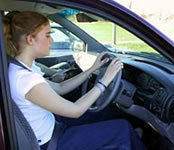 Graduated
Driving Graduated
Driving
Teenagers
have more chance of having an accident than adults do,
but don't despair. A study in the Journal of Adolescent
Research has shown that parents can improve the odds. One
of the most effective methods is called "graduated driving."
By gradually giving your teenagers
greater latitude, you can help them to gain the skills
they need to be good drivers. There are many
possible ways to design a "graduated driving" program,
here is just one sample.
Beginners Stage
It is best to inculcate safe habits at
the outset. So, the rules for beginners are strict.
- Must drive with licensed adult at all times.
- No driving at night (when many
fatal accidents occur).
- No drink driving.
- No smoking while driving.
- No talking on the phone while
driving.
- No driving in bad weather (ice,
rain storms).
- Safety belts must always be worn.
If your teenager has no traffic violations
or accidents for four to six months, it is time to move
to the Intermediate Stage.
Intermediate Stage
Teenagers who have proven themselves reliable
may be given more freedom.
- May drive without supervision during daylight.
- Must have a licensed adult
present when driving at night.
- Only one passenger permitted
when driving without supervision (to minimise
distractions).
- No drink driving.
- No smoking or talking on the phone while driving.
- Safety belts worn by driver and passenger.
If your teenager has no traffic violations
or accidents for four to six months in the Intermediate
Stage, it is time to move to the next level.
Independent Stage
- May drive unsupervised at all
times.
- No drink driving.
- No smoking or talking on a
hand-held phone while driving.
- Safety belts worn by driver and passengers.
Should your teenager have an accident
or commit a traffic violation in the first six months of
independent driving, revert back to the Intermediate Stage.
Continue
to page 3 >

|

